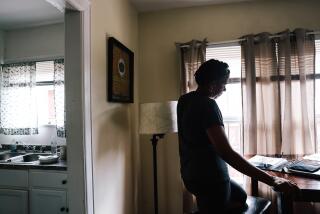Zero to 40 in Four Minutes Flat : Aging Steve Scott Finds He Still Has Miles to Go Before He Retreats
- Share via
Jack Benny would be appalled.
Here’s a guy who can’t wait to turn 40.
But Steve Scott still has a long wait--he turns 38 in May.
Why the rush? He wants to be the first 40-year-old to run a 4-minute mile.
“Every so often, I compute how many months are left,” he said between workouts for his record 15th appearance in Saturday’s Sunkist Invitational at the Sports Arena.
“It’ll be a great challenge for me--as important to me as anything I’ve ever done.”
Four-minute (or faster) miles are feats with which Scott has some familiarity. He has run 136 of them, believed to be a record.
Of course, sub-fours become a bit more difficult the closer one gets to 40. And Scott must first sweat out assaults on the first sub-four for a 40-year-old by athletes slightly older.
“My main competition right now is Eamonn Coghlan of Ireland,” Scott said. “Eamonn is 41, and had a pretty good run at it last year. He got down to 4:01.
“It sort of looks to me like Eamonn might not make it, particularly if he doesn’t get it in this indoor season.
“And if he doesn’t, then the top prospect would be Dave Moorcroft of England, who recently turned 40. He ran a 4:02 last summer.”
Once, a four-minute mile was a bad race for Scott.
His 3:47.69 at Oslo in 1982 is still the fastest mile run by an American. He still calls that race, only three-tenths of a second off the world record at the time, the high point of his career.
In the Sunkist, he’ll be returning to the scene of his first four-minute mile, when he ran 3:59.7 as a 20-year-old in 1977.
He says the transition from running the mile in his peak years to “senior citizen” competition is more mental than physical.
“I didn’t notice any problem with training until I was 34 and 35,” he said.
“That was a tough transition for me. I first noticed then that I needed extended recovery periods from workouts. Before, I went hard every day. All of a sudden, I needed three and four days to recover from a tough workout.
“Mentally, it was tough to accept that. I mean, I wanted to do what I did in my 20s. I finally had to understand that while I was as good a miler at 35 as I was at 25, I needed different training methods to get the same results.
“I’ve been at this so many years, I have a great strength base. I’ve created a miler’s body, essentially. But I’ve reached an age where I just have to apply more intelligence to my training.”
Scott said he dropped off the list of America’s top 10-rated milers last year for the first time since the 1970s, but added that he isn’t all that far removed from his prime.
“If I have a long time to peak for one race, I’m pretty close to my best,” he said. “But I can’t run great races close together.”
When old milers break down, he said, they do so very quickly. He cited the cases of two old rivals, New Zealand’s John Walker and Ireland’s Coghlan. Both are now close friends of Scott’s.
“John came down with an Achilles’ (tendon) problem when he was 34, that he should have taken care of surgically at the time,” Scott said.
“But he didn’t and he kept trying to run on it. It just got worse. Now, he can’t even jog.
“Eamonn tells me he’s had a lot of problems with slow-healing injures since he turned 38. Now, he says if he gets the slightest calf or hamstring pull, he stops and takes care of it immediately.”
If anyone else out there is considering a sub-four mile at 40, or any other high-level running performance, Scott has another tip: Get a coach.
He’s presently coached by Irv Ray, cross-country coach at Azusa Pacific.
Why would a guy who has run 136 four-minute miles need a coach? Is there anyone out there who knows more about running the mile than Scott himself?
“You need someone to bounce ideas off of, more than anything,” he said.
“And I need someone to pull in my reins. Ray puts my program together. No matter how much you know, you need someone to monitor what you’re doing, and to tell you when to back off.
“From 1985 through ‘87, and from ’90 through ‘92, I didn’t have a coach. But I should have, in all those years.”
Scott, who lives in Leucadia, says he does one quality interval workout a week, at UC San Diego or a Del Mar golf course.
“A typical workout now might be three miles of 200 (yards), each between 30 and 40 seconds, followed by a two- or three-mile run on grass,” he said.
“Then I do six repeat 300s, at 43, 45 and 47 seconds. I used to do something like that three times a week, then do six- to 10-mile runs in between.
“I hurt all over the next day now. At 25, it was no problem.”
Finding the exact blend of world-class workouts and rest isn’t as easy as it sounds.
“My last three years have been very frustrating,” he said. “I just couldn’t get it right, training versus rest.
“I’ve had a problem with overtraining most of my career, not just now. When you’re overtrained, you come to a point in a race where your legs suddenly feel like tree trunks.
“You can overtrain for a month and not notice anything. But it comes on very quickly and then you need rest. Now, I kind of have it figured out. I’m more aware than ever of the importance of rest. I went from my (UC Irvine) days through 1988 with no time off at all.” Scott grew up in Upland, the son and brother of doctors. He and his wife, Kim, have three children--son Corey, 12; daughter Megan, 10, and son Shawn, 1 1/2. Corey, he reports, is a comer.
“He has potential,” Scott said. “He’s got a very nice stride, but he’s had no training.”
Nearly 20 years ago, Scott arrived at UC Irvine as a track prospect of modest credentials: He ran a 4:16 mile in high school, and finished second in the half mile at the State meet.
He talks a lot these days of concessions to age in gearing his workouts, of being wary of even minor injuries.
One thing he has had plenty of, however, is the desire to run.
“Enthusiasm has never been a problem,” Scott said. “I still love to run. I look forward to my meets now as much as I ever did.”
More to Read
Go beyond the scoreboard
Get the latest on L.A.'s teams in the daily Sports Report newsletter.
You may occasionally receive promotional content from the Los Angeles Times.










